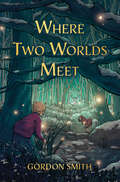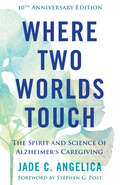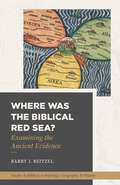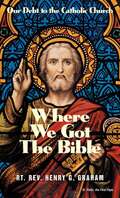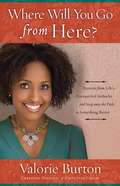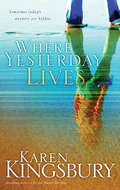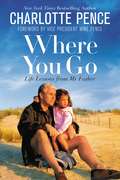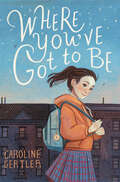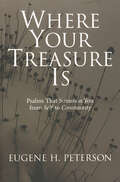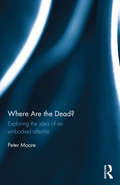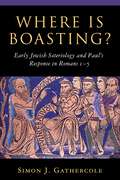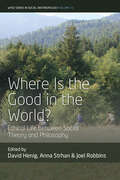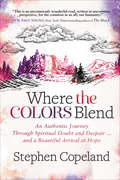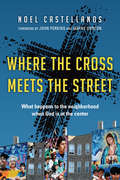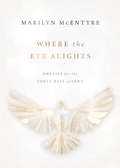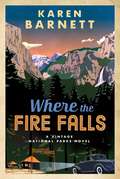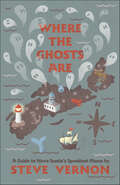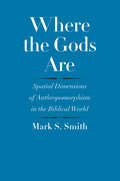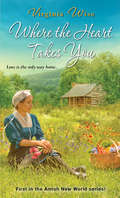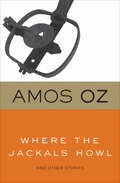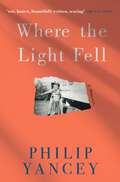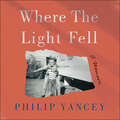- Table View
- List View
Where Two Worlds Meet
by Gordon SmithFrom internationally renowned medium, spiritual teacher and bestselling author Gordon Smith comes a captivating tale about finding your way through death, grief and loss.'Nothing that lives can truly die,' said the stag, 'but we must all experience a winter in our lives, otherwise we haven&’t truly lived.'Following the tragic death of his sister, 10-year-old Dill's life changes forever. In an attempt to escape their grief, Dill and his parents move to his grandmother&’s remote cottage in the countryside. Isolated from his family, who are struggling to come to terms with their loss, Dill spends his time exploring the wild landscape with his trusty spaniel, Bramble. He soon learns that life in his new home, the Dip-n-Dells, is anything but lonely.With the help of his grandmother, Dill learns a magical language that allows him to befriend the animals of the Dip-n-Dells and uncover the secrets of the mystical landscape around him. As his friends in nature help him to understand the cycles of life and death, the cloud of sadness surrounding Dill begins to lift. Determined to share this gift with his parents, Dill and his friends set out to bring light back into their lives. In doing so, he finds out that where love is involved, anything is possible....
Where Two Worlds Touch: The Spirit and Science of Alzheimer’s Caregiving
by Jade C. AngelicaA stunning 10th anniversary edition of Rev. Dr. Jade C. Angelica’s beloved memoir and pastoral guide for those who love someone with Alzheimer's. With a new foreword by Dr. Stephen G. Post.In 2001, Jade C. Angelica's mother was diagnosed with Alzheimer's disease, and thus began a surprising and transformative journey for both mother and daughter. From the early stages of the disease until her mother died, Angelica was dedicated to her mother's care. In that time she learned about grief, relationship, the nature of selfhood, and the unexpected blessings of Alzheimer's disease. She also found a purpose and embarked on her life's work—to teach that people with Alzheimer's can have meaningful lives, relationships, joy, and growth. Where Two Worlds Touch is both a memoir and a pastoral guide for those who love someone with Alzheimer's. It offers heartfelt wisdom on preserving connection, self-care, and staying open to the possibility of grace.In this updated 10th anniversary edition of her beloved book, Angelica adds more learnings from her years in Alzheimer’s ministry and important discoveries from the world of science. She draws on interfaith theological and spiritual resources, historical information, medical research, social context, and practical know-how from professional and family caregivers, as well as her own life’s story to provide a life-changing resource for those who need its gifts.
Where Two Worlds Touch: The Spirit and Science of Alzheimer’s Caregiving
by Jade C. AngelicaA stunning 10th anniversary edition of Rev. Dr. Jade C. Angelica’s beloved memoir and pastoral guide for those who love someone with Alzheimer's. With a new foreword by Dr. Stephen G. Post.In 2001, Jade C. Angelica's mother was diagnosed with Alzheimer's disease, and thus began a surprising and transformative journey for both mother and daughter. From the early stages of the disease until her mother died, Angelica was dedicated to her mother's care. In that time she learned about grief, relationship, the nature of selfhood, and the unexpected blessings of Alzheimer's disease. She also found a purpose and embarked on her life's work—to teach that people with Alzheimer's can have meaningful lives, relationships, joy, and growth. Where Two Worlds Touch is both a memoir and a pastoral guide for those who love someone with Alzheimer's. It offers heartfelt wisdom on preserving connection, self-care, and staying open to the possibility of grace.In this updated 10th anniversary edition of her beloved book, Angelica adds more learnings from her years in Alzheimer’s ministry and important discoveries from the world of science. She draws on interfaith theological and spiritual resources, historical information, medical research, social context, and practical know-how from professional and family caregivers, as well as her own life’s story to provide a life-changing resource for those who need its gifts.
Where Was God on September 11?
by John BlanchardOn 11 September 2001, terrorists hijacked four commercial airliners in the United States. Two were rammed into the twin towers of the World Trade Center in New York City and a third into the Pentagon in Washington, DC. Passengers on the fourth plane fought with the hijackers, but it crashed in Pennsylvania with the loss of all on board. In the most devastating terrorist attack in history, the world’s tallest building had been reduced to rubble and some 3,000 people blasted or crushed to death. The Times called it ’The day that changed the modern world’. Another newspaper claimed, ’History will never be the same again.’ In a CNN Time Warner poll taken three months later, 73% of those interviewed said, ’It has changed everything for ever. As the media teemed with speculation as to how such a thing could have happened, and what the repercussions might be, many people were asking one inescapable question: Where was God on September 11? The answer may surprise you ...
Where Was the Biblical Red Sea?: Examining the Ancient Evidence (Studies in Biblical Archaeology, Geography, and History)
by Barry J. BeitzelWhere was the Red Sea of Exodus? Exodus records that the waters of the Red Sea (or Reed Sea) opened up to deliver Israel and plummeted down to destroy their Egyptian pursuers. But if the Red Sea cannot be located, can we trust the claims of the Bible? Some have suggested relocating the events. Others suggest they never happened at all. In Where Was the Biblical Red Sea? Beitzel challenges popular alternatives and defends the traditional location: that the biblical Red Sea refers to a body of water lying between the eastern Nile Delta and Sinai. Beitzel rigorously reexamines the data--both typical and overlooked--ranging from biblical and classical sources to ancient and medieval maps. His comprehensive analysis answers objections to the traditional view and exposes the inadequacies of popular alternatives. Ancient geography excavates the biblical world and its story. Readers will better understand and appreciate the biblical story as well as its historicity and reliability. Where Was the Biblical Red Sea? is a foundational reference work for any discussion of the Exodus event.
Where We Got the Bible... Our Debt to the Catholic Church
by Henry G. GrahamA perennial favorite. This short treatise outlines the history of the Bible in complete, yet simple terms. Shows how the Catholic Church has determined and proclaimed through her infallible rulings just which books are actually part of Sacred Scripture, and how she has preserved and maintained the Bible throughout the centuries. A real eye-opener, especially for anyone who thinks the Bible is a Protestant book.
Where Will You Go from Here?: Moving Forward When Life Doesn't Go as Planned
by Valorie BurtonHas the unexpected knocked you off course? You lost your job to the latest round of layoffs. A relationship you thought would last forever, didn't. A health challenge is disrupting your life. Life doesn't always go according to plan, but with the right attitude and skills, you can persevere through even the toughest situations--and emerge stronger and better than ever. Resilience to Get Through Any Challenge In Where Will You Go from Here? Valorie Burton helps you navigate life's obstacles and unexpected challenges. You'll find all the tools you need to be resilient in the face of setbacks, now and in the future, including: · The Five Commitments that propel every successful comeback· Step-by-step guidance for restructuring your life · Strategies to unearth the courage you need for any situation· In-the-heat-of-the-moment words to combat negative thinking· Practical exercises to become better, not bitter, as a result of adversity Packed with uplifting insights and powerful principles, this personal coaching resource offers the wisdom and encouragement you need to think differently about your circumstances and take hold of the lessons God is offering you. As you experience the "post-traumatic growth" that comes only through adversity, you'll be equipped to unleash a stronger, more authentic you.From the Trade Paperback edition.
Where Yesterday Lives: Three Novels In One - Where Yesterday Lives, When Joy Came To Stay, On Every Side
by Karen KingsburyAt thirty-one, Ellen Barrett has already won a Pulitzer prize. Sadly, though, her skill as a journalist far surpasses her ability to sort out her troubled past, so she's less than eager to return to picturesque Petoskey, Michigan, for her beloved father's funeral. When she most needs comfort, her husband is distant and her siblings antagonistic -- and the solace an old sweetheart offers is almost too much to resist. In the end, going home to the shores of Little Traverse Bay is an emotional and spiritual journey for Ellen -- a rediscovery of what is truly important and eternal in her life.From the Trade Paperback edition.
Where You Go: Life Lessons from My Father
by Charlotte Pence Mike PenceA stirring portrait of Vice President Mike Pence from his own daughter: the story of a Christian husband and father who answers the call to serve America with his family by his side. When Mike Pence set out on the vice presidential campaign trail, his daughter Charlotte knew the next 100 days would be exciting and challenging. But she also knew that her father-a dedicated public servant-would succeed because he'd cling to his faith, his love for America, and his family every step of the way. New York Times bestselling author Charlotte Pence pays tribute to her father, revealing the lessons he has taught her from his rich spiritual life. Through favorite memories from childhood and vivid moments captured on the campaign trail, like the times she helped her dad prepare for debates, Charlotte offers a compelling story of love, hope, and how to overcome adversity. Featuring a foreword from Vice President Mike Pence and a sixteen-page color photo spread, Where You Go is an uplifting celebration of family that will inspire audiences of all ages and backgrounds.Chapters include:Trust the Grand Plan Speak Your Dreams Determine Your Heroes, and Find Strength in Your Differences.
Where You've Got to Be
by Caroline Gertler“Heartfelt, honest, and beautifully told—Nolie’s NYC story is a must-read. Bonus points for an absolutely amazing Grandma character!” —Lisa Greenwald, author of The Friendship List and TBH series Feeling left behind by both her sister and her best friend, Nolie tries her best to belong but soon finds herself at a moral crossroads. Set in the bustle of New York City during the Jewish High Holy Days, Where You’ve Got to Be is an accessible story about identities and relationships—the ones you keep and ones you let go. Pitch-perfect for tween readers who love Rebecca Stead, Holly Goldberg Sloan, and contemporary realistic stories.Nolie’s sister, Linden, may be only fourteen months older than she is, but suddenly that feels longer than it ever has before. Linden is growing up. She cuts short their Cousins Week at Grandma’s beach cottage to focus on excelling in her ballet auditions, and she throws away the seashell necklace Grandma gave each of them—though Nolie secretly saves it. Even Nolie’s best friend, Jessa, is suddenly trying to act older and cooler, and she wants Nolie to be someone different, too.With everything and everyone changing around her, Nolie starts to feel adrift. Should she be changing, too? Who does she want to be? One impulsive decision leads to another and another . . . until Nolie has a secret collection of things that don’t belong to her. Now, Nolie must face the fact that she may have ended up on the wrong path so she can start to find her way back.This voice-driven read hits the sweet spot for readers of The Remarkable Journey of Coyote Sunrise and Finding Orion.
Where Your Treasure Is: Psalms that Summon You from Self to Community
by Eugene H. PetersonThis is a bold book. It has to do with changing the life of American society, from the inside out, through "source action" of prayer. "I have written a book for Christians," says Eugene Peterson, "who want to do something about what is wrong with America and want to plunge into the center, not tinker at the edge. I have chosen eleven psalms that shaped the politics of Israel and can shape the politics of America, and I have taken them seriously...I have written to encourage Christians to pray them both as children of God with eternal destinies and as American citizens with daily responsibilities in caring for our nation." Peterson is concerned with the "unselfing" of our self-preoccupied, self-bound society through the action of praying together with other believers. He offers insightful, thought-provoking reflections on eleven select psalm-prayers that can help us overcome such things as self-centeredness, self-assertiveness, self-righteousness, self-sufficiency, self-pity, self-service, and self-love. Originally published under the title Earth and Altar and now being reprinted for wider distribution,Where Your Treasure Is provides solid fare for any thoughtful, concerned Christian. But the book is especially suitable for group study and discussion: what Peterson writes here will serve to stir small groups of Christians to pointed reflection and prayer-action.
Where are the Dead?: Exploring the idea of an embodied afterlife
by Peter MooreWhere are the dead? What are they doing? What kind of a process is dying? What relationships exist among the dead themselves, and between the dead and those in the world they have left behind? Modern philosophers argue that the idea of disembodied survival - to which many believers pay lip service - is incoherent, and that there can be evidence neither for nor against something incoherent. By contrast, this book argues, the idea of an embodied survival (albeit a form of embodiment differing from our present embodiment) makes perfect sense in itself and fits much better with the alleged evidence for post-mortem survival. Exploring post-mortem survival, Where are the Dead? uses a variety of empirical data, alongside mythological, legendary and purely fictional material, to illustrate how the less familiar idea of embodied post-mortem survival might actually ’work’ in some real afterlife environment. By asking questions about the nature and whereabouts of the afterlife, and about what it might be like to be dead, the book explores themes nowadays relatively neglected even in disciplines explicitly concerned with ideas about death, dying and life after death.
Where is Boasting?: Early Jewish Soteriology and Paul's Response in Romans 1–5
by Simon J. GathercoleThis important work challenges the validity of the "New Perspective" on Paul and Judaism. Working with new data fom Jewish literature and a fresh reading of Romans 1–5, Simon Gathercole produces a far-reaching criticism of the current approach to Paul and points a new way forward. Building on a detailed examination of the past generation of scholarship on Paul and early Judaism, Gathercole's work follows two paths. First, he shows that while early Judaism was not truly oriented around legalistic works-righteousness, it did consider obedience to the Law to be an important criterion at the final judgment. On the basis of this reconstruction of Jewish thought and a rereading of Romans 1–5, Gathercole advances his main argument — that Paul did indeed combat a Jewish perspective that saw obedience to the Law both as possible and as a criterion for vindication at the final judgment. Paul's reply is that obedience to the Law is not a criterion for the final judgment because human nature makes obedience to the Law impossible. His doctrine of justification can therefore be properly viewed in its Jewish context, yet anthropological issues also take center stage.
Where is the Good in the World?: Ethical Life between Social Theory and Philosophy (WYSE Series in Social Anthropology #12)
by Joel Robbins David Henig, Anna StrhanBringing together contributions from anthropology, sociology, religious studies, and philosophy, along with ethnographic case studies from diverse settings, this volume explores how different disciplinary perspectives on the good might engage with and enrich each other. The chapters examine how people realize the good in social life, exploring how ethics and values relate to forms of suffering, power and inequality, and, in doing so, demonstrate how focusing on the good enhances social theory. This is the first interdisciplinary engagement with what it means to study the good as a fundamental aspect of social life.
Where is the Good in the World?: Ethical Life between Social Theory and Philosophy (WYSE Series in Social Anthropology #12)
by Joel Robbins David Henig, Anna StrhanBringing together contributions from anthropology, sociology, religious studies, and philosophy, along with ethnographic case studies from diverse settings, this volume explores how different disciplinary perspectives on the good might engage with and enrich each other. The chapters examine how people realize the good in social life, exploring how ethics and values relate to forms of suffering, power and inequality, and, in doing so, demonstrate how focusing on the good enhances social theory. This is the first interdisciplinary engagement with what it means to study the good as a fundamental aspect of social life.
Where the Colors Blend: An Authentic Journey Through Spiritual Doubt and Despair … and a Beautiful Arrival at Hope
by Stephen CopelandIn Where the Colors Blend, Stephen Copeland&’s self-discovery and God-discovery is told over a period of six years in the context of an annual retreat to the Blue Ridge Mountains in Roanoke, Virginia, where an obscure, forty-year-old church softball tournament takes place each summer to raise funds for mission work in Paraguay. In stepping into these stories, and sharing them with the reader, Stephen simultaneously journeys deeper within himself, discovering the divine in the process and taking readers deep into the throes of doubt, deconstruction, and depression. But it&’s there, in the darkness, that an authentic hope finds him. Throughout the narrative, readers experience with Stephen a number of paradigm shifts in the areas of: Spirituality: from exhausting oneself trying to get close to God to simply abiding: awakening to who we already are at the core of our beings as children of God.Psychology: from suppressing emotions, pains, and insecurities to curiously and non-judgmentally exploring them.Relationships: from trying to change others or silently judging them to accepting others as they are and learning from those who are most different than ourselves: abandoning ignorance and arrogance.Art, writing, and work: from being taunted by internal demands and a relentless pursuit of perfection to simply enjoying the gift of the process. Stephen's present-tense narrative, mysteriously unfolding all the way, is free-thinking and free-flowing, swinging from humor to complex theology, from someone else&’s story to sudden introspectiveness and application, creating a unique experience for readers as it challenges them to adopt their own lifestyle of introspection and contemplation.
Where the Cross Meets the Street: What Happens to the Neighborhood When God Is at the Center
by Noel CastellanosMissio Alliance Essential Reading List of 2015 The cross means more than we've let it mean. Proclaiming the gospel and forming the faithful: these are the most practiced disciplines of the evangelical church. As central as these disciplines are, however, they are only part of the story. And as Christian Community Development Association CEO Noel Castellanos has learned over a lifetime of ministry and mission, the neglect of the gospel's full implications for the world has contributed to the erosion of communities and the languishing of poor and other marginalized people. In Where the Cross Meets the Street Castellanos shows the strengths and limitations of a narrowly focused church and broadens our imaginations to embrace a gospel that proclaims Christ and forms disciples. This life-giving gospel also demonstrates compassion, confronts injustice and restores individuals and communities to wholeness. This is the whole work of the cross; this is the privilege of those who follow the Word made flesh.
Where the Eye Alights: Phrases for the Forty Days of Lent
by Marilyn McEntyreLent is about more than going to church on weekdays and giving up chocolate or social media. It&’s also a time to form one&’s heart and mind through study and prayer. In Where the Eye Alights, Marilyn McEntyre offers forty short meditations, based on excerpts from Scripture and poetry, that guide readers on a devotional journey from Ash Wednesday through Holy Saturday. As in lectio divina—the spiritual practice of reading Scripture repetitively and meditatively—McEntyre invites us to notice words that may give us pause and summon us to reflection. This book calls our attention to how the Spirit speaks through phrases that can open doors to deep places for those willing to sit still with them. &“Lent is a time of permission,&” says McEntyre. &“Many of us find it hard to give ourselves permission to pause, to sit still, to reflect or meditate or pray in the midst of daily occupations—most of them very likely worthy in themselves—that fill our waking minds and propel us out of bed and on to the next thing. We need the explicit invitation the liturgical year provides to change pace, to curtail our busyness a bit, to make our times with self and God a little more spacious, a little more leisurely, and see what comes. The reflections I offer here come from a very simple practice of daily meditation on whatever has come to mind in the quiet of early morning.&”
Where the Fire Falls: A Vintage National Parks Novel
by Karen BarnettStunning Yosemite National Park sets the stage for this late 1920s historical romance with mystery, adventure, heart, and a sense of the place John Muir described as "pervaded with divine light."Watercolorist Olivia Rutherford has shed her humble beginnings to fashion her image as an avant-garde artist to appeal to the region's wealthy art-collectors. When she lands a lucrative contract painting illustrations of Yosemite National Park for a travel magazine, including its nightly one-of-a-kind Firefall event, she hopes the money will lift Olivia and her sisters out of poverty. After false accusations cost him everything, former minister Clark Johnson has found purpose as a backcountry guide in this natural cathedral of granite and trees. Now he's faced with the opportunity to become a National Parks Ranger, but is it his true calling? As Clark opens Olivia's eyes to the wonders of Yosemite, she discovers the people are as vital to the park's story as its vistas--a revelation that may bring her charade to an end.
Where the Ghosts Are: A Guide to Nova Scotia's Spookiest Places (Ginny Ross Series)
by Steve VernonIf you’re from Halifax, you’ve probably heard that the Five Fisherman Restaurant is supposedly haunted, and that Georges Island is overrun with ghosts. If you’re from Nova Scotia, you probably know about rumours of buried treasure on Oak Island, or about the UFO sighting in Shag Harbour. But what about the Grey Lady of Stoney Beach? Or the Ghost of Haddon Hall? Featuring addresses and GPS coordinates, this guide to Nova Scotian haunts maps out the origin stories of 50 spooky tales.
Where the Gods Are: Spatial Dimensions of Anthropomorphism in the Biblical World
by Mark S. SmithThe issue of how to represent God is a concern both ancient and contemporary. In this wide-ranging and authoritative study, renowned biblical scholar Mark Smith investigates the symbols, meanings, and narratives in the Hebrew Bible, Ugaritic texts, and ancient iconography, which attempt to describe deities in relation to humans. Smith uses a novel approach to show how the Bible depicts God in human and animal forms--and sometimes both together. Mediating between the ancients' theories and the work of modern thinkers, Smith's boldly original work uncovers the foundational understandings of deities and space.
Where the Heart Takes You (Amish New World #1)
by Virginia WiseIn this sweeping new historical series by Virginia Wise, a young woman finds a new life in America’s first Amish settlement—and discovers that love requires a special sort of courage . . . Pennsylvania, 1737. Greta Scholtz braved a perilous journey—and the loss of her beloved father—to find religious freedom in America. With two orphan children she's taken under her wing, she's trying hard to survive this rugged new world. So she won't let settlement elders pressure her into marrying reserved widower Jacob Miller. She and Jacob simply can’t agree on anything—even if the unexpected feeling between them is proving an irresistible force . . . After losing his wife and baby, grief-stricken Jacob keeps everyone at arm’s length. Duty is the only reason he began helping the headstrong Greta make a life for herself and her charges. Yet he’s grown to admire her, especially her strength in the face of obstacles—including him and his wounded ways. But wrenching misunderstandings and a jealous rival could separate them forever. To find harmony—and perhaps even a future together—Greta and Jacob must take a leap of faith and risk opening their hearts . . .
Where the Jackals Howl: And Other Stories
by Amos OzThe first book from the acclaimed, award-winning author of A Tale of Love and Darkness and the New York Times Notable Book, Scenes from Village Life. The Washington Post praised Israeli author Amos Oz as &“one of our essential writers, laying out for our observation, in ever-increasing breadth and profundity, the mad landscape of our time and his place.&” Here, in his first book, is a disturbing and moving collection of short stories about kibbutz life. Each of the eight stories in this volume grips the reader from the first line, and convey the tension and intensity of feeling in the founding period of Israel, a brand-new state with an age-old history. Some are love stories, more are hate stories, and frequently the two urges intertwine. &“A strong, beautiful, disturbing book. It speaks piercingly—whether wittingly or unwittingly, I know not—of a dimension of the Israeli experience not often discussed, of the specter of the other brother, of a haunting, an unhealed wound; it reminds us of polarizations everywhere that bind and diminish us, that may yet rend us.&” —The New York Times &“As you read, you feel yourself, in all these stories, sinking deeper into the loam of Oz&’s sensibility, a paradoxical mix of sensuality and disdain. A good collection by an important international writer.&” —Kirkus Reviews (starred review)
Where the Light Fell: A Memoir
by Philip Yancey'Not until college days do I discover the shocking secret of my father's death.'With a journalist's background Philip Yancey is widely admired for taking on the more difficult and confusing aspects of faith. Now in Where the Light Fell he shares, for the first time, the painful details of his own origins - taking us on an evocative journey from the backwoods and Bible-belt pockets of the South to the bustling streets of Philadelphia; from trailer parks to church parking lots; from dark secrets and family oddballs to fire-and-brimstone preachers and interminable church services. Raised by their impoverished single mother, Philip and his brother Marshall struggle to comprehend her speeches about their dead father, an Old Testament Bible story, and sons sacrificed for a divine cause.This coming-of-age story is a slice of life, both intensely personal and broadly resonant, set against a turbulent time in post-WWII American history shaped by the racism and paranoia of fundamentalist Christianity and reshaped by the mounting pressures of the Civil Rights movement and 60s-era forces of social change. An unforgettable read, it is at once hugely funny, deeply disturbing and achingly poignant. A testament to the power of the human spirit, Where the Light Fell illuminates Yancey's ability to bring comfort to those bruised by the church, and hope to those who can't imagine ever finding a healthy faith.
Where the Light Fell: A Memoir
by Philip Yancey'Not until college days do I discover the shocking secret of my father's death.'With a journalist's background Philip Yancey is widely admired for taking on the more difficult and confusing aspects of faith. Now in Where the Light Fell he shares, for the first time, the painful details of his own origins - taking us on an evocative journey from the backwoods and Bible-belt pockets of the South to the bustling streets of Philadelphia; from trailer parks to church parking lots; from dark secrets and family oddballs to fire-and-brimstone preachers and interminable church services. Raised by their impoverished single mother, Philip and his brother Marshall struggle to comprehend her speeches about their dead father, an Old Testament Bible story, and sons sacrificed for a divine cause.This coming-of-age story is a slice of life, both intensely personal and broadly resonant, set against a turbulent time in post-WWII American history shaped by the racism and paranoia of fundamentalist Christianity and reshaped by the mounting pressures of the Civil Rights movement and 60s-era forces of social change. An unforgettable listen, it is at once hugely funny, deeply disturbing and achingly poignant. A testament to the power of the human spirit, Where the Light Fell illuminates Yancey's ability to bring comfort to those bruised by the church, and hope to those who can't imagine ever finding a healthy faith.(P) 2021 Hodder & Stoughton
